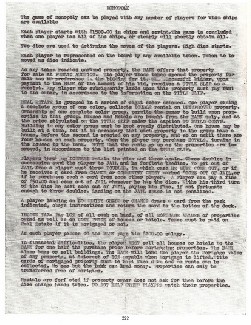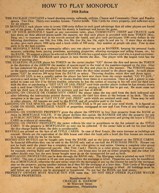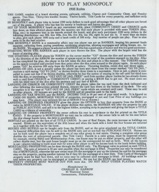Rules 1933 to 1935 (USA)
Rules are rules, right? Well, not quite. The rules to the game of Monopoly have been changed, tweaked, adjusted, and simplified many times over the years. Even discounting all the rules changes before mass production began in 1934 Darrow and Parker Brothers have changed the rules numerous times over the years. There are at least 6 different sets of rules for 1935 alone. I'll try to list all the different sets of rules and point out the major differences between them.
When Charles Darrow was taught the game of Monopoly by Charles Todd the rules were passed along by word of mouth. Darrow asked Todd for a set (actually 12) of written rules. Todd had his secretary type up the copies and asked for input from Jesse Raiford and Ruth Hoskins to insure they were as complete and correct as possible. What is believed to be one of these copies is shown here as well as a reproduction of these rules.
As Charles Darrow started making and selling sets he ran out of the rules provided by Todd. As he started typing his own rules some changes were inevitable. These were small changes, such as removing typos and re-wording few things to make the rules his own.
By 1934 Darrow was ready to mass produce the game and revamped rules were included with this set. No longer was it an auction-monopoly, but was Monopoly with the properties available for sale to the player landing on it for twice its mortgage value.
This is the first set of rules to show the distribution of the $1500: one 500, five 100s, five 50s, five 20s, ten 10s, eight 5s, and ten 1s. This is also the most complete set of rules to date. These rules are on the cardboard insert inside the Darrow White Box set.
In 1935 Darrow had 5900 sets made. Retailers thought the White Box was too big and took up too much shelf space and wanted Darrow to provide them with a smaller game. The small Black Box set was the result of this.
Since there was no insert in this game the rules were put on paper. The only difference I see in this set from the 1934 rules is the option to pay $300 instead of 10% on Income Tax.
When Parker Brothers bought the rights to Monopoly one of the first things they did was rewrite the rules. This turned out to be a rewrite of Darrow's rules with some changes in an attempt to make them more clear. This created a wordier set of rules, but they are easier to follow. These rules are found in some hybrid sets and in early Trade Mark sets.
The second set of Trade Mark rules was used in later Trade Mark sets and Early Patent Pending Sets. This set is very similar to the first with a few more clarifications. The biggest change seems to be that mortgaged properties can now be traded.
Wordier still, the third set of Trade Mark rules was used in many Patent Pending sets. These rules use a lot of bold print to draw attention to important aspects of the game. This is also the first set of rules to state that tokens are included in the game. I believe these rules changes were made as a result of questions and input from consumers. I have two versions of these rules, one with hypens on page two when words are broken at the end of a line, and one without the hyphens.
Later Patent Pending sets contained a completely revamped set of rules. This new set of rules had a picture of the game at the top and was a bi-fold, four page set of rules. The rules are similar to the Trade Mark rules but do show the first use of TITLE DEED. This is significant as TITLE DEED was used in the 1924 Landlords Game patent and shows that when these rules were prepared that the purchase of the patent had been made or was imminent. This is also evidence that his was an extremely short run. These rules also offer rules for a shorter game for the first time. Also mentioned in these rules is prices for properties being on the board.
The next set of rules was produced after the Landlords Game patent was obtained (Patent 1,509,312). The biggest change I see is in the distribution of the money at the beginning of the game: one 500, six 100s, four 50s, three 20s, ten 10s, seven 5s, and five 1s. There's also indication that there's more money in the game as Patent Pending rules indicate that there's $9000 in the game and Single Patent rules indicate at least $10,500. Other changes include the addition of "In the course of the game, Players will encircle the board several times"after the 4th line on page two, "FULL PURCHASE PRICE" is changed to "FULL PRICE" under MORTGAGES on page 4, and "immediately" is removed in the To Make a Shorter Game section. Also included is a sepparate sheet with short game rules.
These rules can be found in some very late Patent Pending games and some Patent 1,509,312 games. The rules were quickly changed again. This second set of rules is identical to the first on page one, but on page two the changes begin. First the sentence "In the course of the game, Players will encircle the board several times" is moved to after the second paragraph. The second change is to Income Tax. "MORTGAGE VALUE" is changed to "Printed PRICE" and the comma in the last sentence of this section is moved to the correct place. There are no changes to page three. On page four the description of how to sell a Hotel is changed.
The second paragraph under "BANKRUPTCY" is rewritten for the sake of clarity. The "MISCELLANEOUS" section has been rewritten for the same reason. "PROPERTY OWNERS MUST WATCH OUT FOR RENTS DUE. DO NOT HELP OTHER PLAYERS WATCH THEIR PROPERTIES" and the different versions available has been eliminated. The short game rules that were on a sepparate sheet are now included after the "MISCELLANEOUS" section. These rules appear in later Patent 1,509,312 and in early Patent 1,509,312-2,026,082 games.



